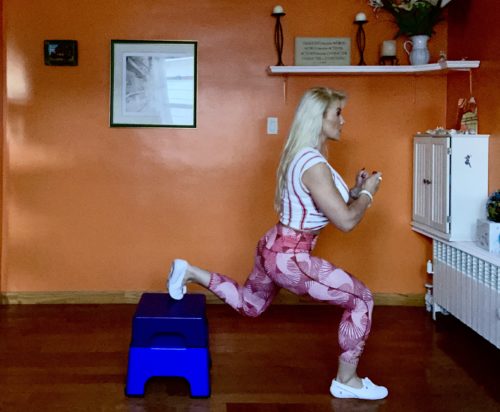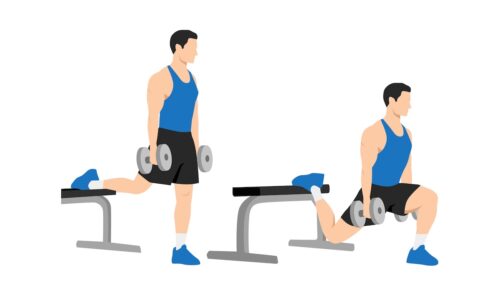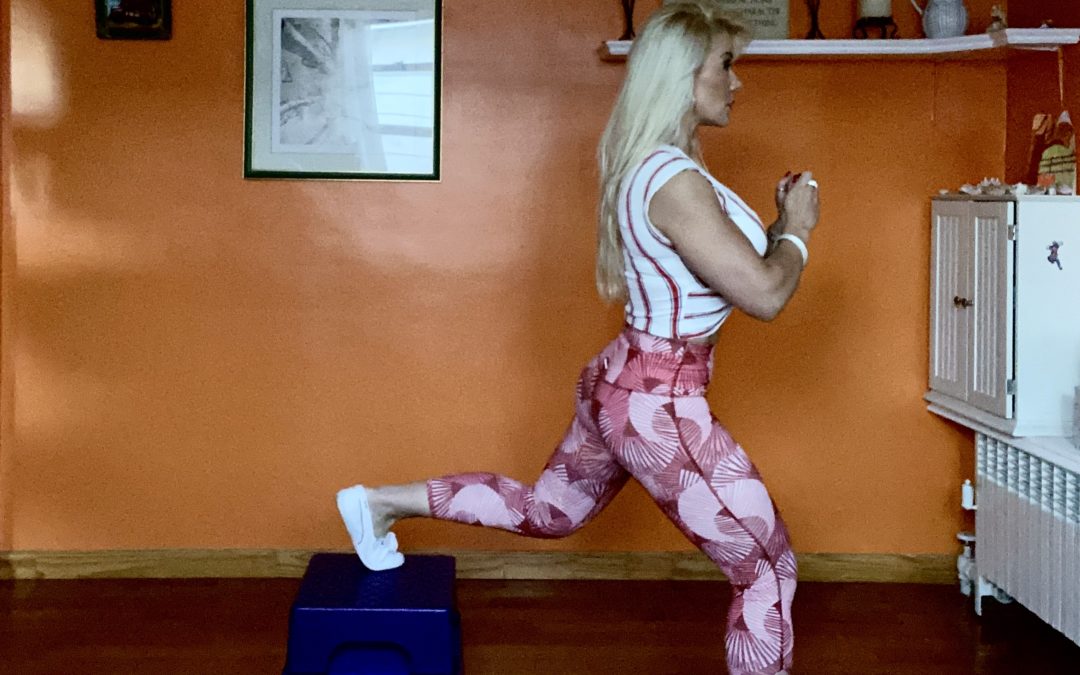Variation is very important when you want to make changes to your physique and/or fitness level. Incorporating different exercises for the hams, quads, and glutes and diverse planes of motion, you can make a real difference for your legs and glutes.
A wonderful leg exercise is the Bulgarian Split Squat (BSS). This is a single-leg unilateral squat where the back leg is elevated on a bench or step. Using a single leg at a time develops strength and balance, as well as higher core and upper body engagement.
Below we’ll look deeper into Bulgarian Split Squats and we’ll cover the following:
- Muscles involved in Bulgarian Split Squat
- Benefits associated with Bulgarian Split Squats
- How to properly do Bulgarian Split Squats
- Common mistakes when performing Bulgarian Split Squats
- Video on how to do Bulgarian Split Squats
- Quad and hamstring exercises to complete your leg workout
What Muscles Do Bulgarian Split Squats Work?
Primary Muscles ⤵️
- Quadriceps or Quads: This large muscle group is located on the front of the thigh, the front & sides of the femur. It’s composed of four muscles (rectus femoris, vastus lateralis, vastus medialis, and vastus intermedius). The origin of the name, quad, means four – hence quadricep (four-headed muscle). The quadriceps are knee extensors and hip flexors – essential for in walking, running, jumping, and squatting. They, also, help to stabilize the patella and knee joints.
- Gluteal Muscles (buttocks): These muscles are involved in the extension, abduction, and rotation of the hip joint. They also help keep the body erect and assist human locomotion (running, jumping, sprinting, etc).
- Hamstrings: Located on the posterior thigh in between the hip and the knee, and are composed of three muscle groups (semitendinosus, semimembranosus, and biceps femoris – long and short heads). These muscles are antagonists to the quadriceps and are involved in hip and knee movements. They participate in the deceleration of knee extension and help flex the knee and extend the hips. They are essential for daily movement (walking), speed (running), and deceleration (stopping movement).
- Gastrocnemius: Superficial two-headed muscles that are in the back part of the lower leg, forming the calves. They flex the foot at the ankle joint and the leg at the knee joint. They are involved in fast movements such as running and jumping.
- Core Muscles: The erector spinae (set of muscles that run vertically along the side of the vertebral column, originating at the hip and extending up to the skull. They help rotate and extend the spine and neck) and abs (muscles in the abdominal wall: rectus abdominis, obliques, transverse abdominal) make up the core muscles.
If you hold a weight in front of you or dumbbells by your sides, you can stimulate secondary muscles ⤵️
- Scapular Stabilizers: These muscles function synergistically to anchor the scapula, guide movement, and resist spinal flexion. The muscles involved are the upper back muscles (serratus anterior, rhomboid major and minor, levator scapulae, and trapezius) and the muscles of the rotator cuff (the supraspinatus, infraspinatus, teres minor, and subscapularis).
- Biceps (biceps brachii): These muscles are on the front of the arms and have 2 heads (short and long head)
- Forearms: Located in the upper limbs between the elbows and the wrists. They help hold the weight.

Bulgarian Split Squats’ (BSS) Benefits
- Aesthetics: BSS sculpts your legs and glutes nicely.
- Strength: Working one leg at a time can build stronger legs, which can transfer to bilateral lower-body movements. It makes it highly advantageous when practicing sports too.
- Increased Flexibility & Mobility: This deeper movement increases the length of the hip joint’s range of motion, making it more flexible. In turn, it improves lower body mobility. Mobility restrictions when squatting due to past injuries, long femurs, or long torsos, are not problematic when performing BSS.
- Correct Imbalances: Most people have muscular imbalances in their legs, and even arms, due to favoring one limb over the other. This happens due to previous injuries, athletic demands, or just bad habits. Training unilaterally can correct these imbalances, allowing both legs to be equally developed. This is important because imbalances tend to cause injuries over time.
- Stability: This single-leg exercise can improve stability. BSS puts additional demand on the core and stabilizer muscles, helping you to become more stable in unstable environments.
- Safer: Since you are using less weight, there is less stress on the spine which reduces the risk of injury.
- Less Equipment: You can achieve great results with a fraction of the weight since it’s harder to work each leg individually. You don’t need access to tons of heavyweight – great when traveling.
- Versatility: You can perform BSS in different ways. You can add resistance by using your own body weight, a barbell, dumbbells, kettlebells, a weight plate, a hex bar, or the Smith machine. You can also change the platform where your back leg goes. Having a higher platform allows for a bigger range of motion and depth. On the other hand, a softer surface of the platform forces stabilization in the foot while a harder surface keeps you more sturdy. You can use a flat bench, a step, a stability ball (this requires more balance), TRX rope, or simply a chair/ couch.
How to Do Bulgarian Split Squats

- Get a step, bench, or something else where you can rest one foot. It should be about knee height.
- Stand tall with your back straight, shoulders back, core tight, and hips square to your body.
- Position yourself on a lunge stance placing your back foot elevated on the bench/stepper and your leading leg should be about 20 inches in front of the bench.
- Lower your body until your front thigh is parallel to the floor, keeping your knee in line with your foot. Don’t let your front knee travel beyond your toes.
- Drive up through your front heel back to the starting position.
- Repeat.
Bulgarian Split Squats Mistakes
Now that you know how to perform Bulgarian split squats, pay attention to your form so you can avoid the most common mistakes associated with this exercise:
- Avoid using a lot of weight. Bulgarian split squats are challenging and don’t require you to go heavy. Lifting super heavy at this extreme angle can be tricky. You may not be able to return to your starting position and end up hurting yourself.
- Avoid moving your front leg forward instead of downwards. You must keep the front leg at a 90-degree angle so that your knee doesn’t pass your toes, which can strain the knee joint.
- Avoid keeping your shoulders forward and rounding your back. This puts unnecessary stress on your back.
- Avoid placing the back leg directly behind the front leg. This decreases your base of support and throws off your equilibrium. The Bulgarian is a unilateral exercise so you are already working on your balance – it must be done in a safe way.
- Avoid leaning forward. This diminishes the involvement of the core, which is there to keep you straight and avoid overstressing your front knee.
- Avoid putting your weight on your toes or the ball of your foot, instead carry your weight on your heel. Make sure your front foot is not too close to the bench and you are not leaning forward.
- Avoid over-engaging the back leg. The is there to help you balance not to carry the weight. This is not a lunge but more of a one-legged squat.
- Avoid internally or externally rotating the knee. Your knee should go in the direction of the foot. Otherwise, you overstress your knee.
Bulgarian Split Squats Video
Leg Workout
You can complete your lower body workout with the following exercises:
As you can see, the Bulgarian split squat is a wonderful leg exercise. It offers numerous benefits associated with hypertrophy, improved balance, endurance, and strength. Now that you know the correct form to properly perform Bulgarian split squats, you can avoid the most common mistakes associated with this exercise and complement your lower body workout.
Remember, whether you want to lose weight, tone your body, gain strength, or increase muscle size, all muscles must be trained – Lift, Burn more Fat, Get Stronger, and Live Healthier!
To a Fitter Healthier You,
The Fitness Wellness Mentor



